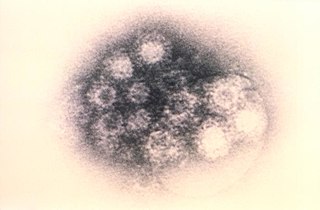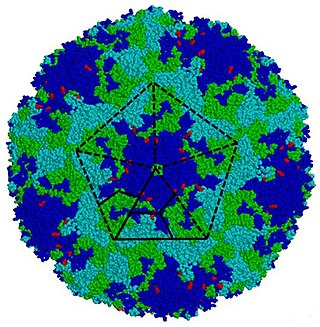
Coxsackie A virus (CAV) is a cytolytic Coxsackievirus of the Picornaviridae family, an enterovirus.

Bornholm disease, also known as epidemic pleurodynia, is a condition characterized by myositis of the abdomen or chest caused by the Coxsackie B virus or other viruses. The myositis manifests as an intermittent stabbing pain in the musculature that is seen primarily in children and young adults.

The rhinovirus is the most common viral infectious agent in humans and is the predominant cause of the common cold. Rhinovirus infection proliferates in temperatures of 33–35 °C (91–95 °F), the temperatures found in the nose. Rhinoviruses belong to the genus Enterovirus in the family Picornaviridae.

Hand, foot, and mouth disease (HFMD) is a common infection caused by a group of enteroviruses. It typically begins with a fever and feeling generally unwell. This is followed a day or two later by flat discolored spots or bumps that may blister, on the hands, feet and mouth and occasionally buttocks and groin. Signs and symptoms normally appear 3–6 days after exposure to the virus. The rash generally resolves on its own in about a week. Fingernail and toenail loss may occur a few weeks later, but they will regrow with time.

Filoviridae is a family of single-stranded negative-sense RNA viruses in the order Mononegavirales. Two members of the family that are commonly known are Ebola virus and Marburg virus. Both viruses, and some of their lesser known relatives, cause severe disease in humans and nonhuman primates in the form of viral hemorrhagic fevers.
Coxsackie B4 virus are enteroviruses that belong to the Picornaviridae family. These viruses can be found worldwide. They are positive-sense, single-stranded, non-enveloped RNA viruses with icosahedral geometry. Coxsackieviruses have two groups, A and B, each associated with different diseases. Coxsackievirus group A is known for causing hand-foot-and-mouth diseases while Group B, which contains six serotypes, can cause a varying range of symptoms like gastrointestinal distress myocarditis. Coxsackievirus B4 has a cell tropism for natural killer cells and pancreatic islet cells. Infection can lead to beta cell apoptosis which increases the risk of insulitis.

Coxsackieviruses are a few related enteroviruses that belong to the Picornaviridae family of nonenveloped, linear, positive-sense single-stranded RNA viruses, as well as its genus Enterovirus, which also includes poliovirus and echovirus. Enteroviruses are among the most common and important human pathogens, and ordinarily its members are transmitted by the fecal–oral route. Coxsackieviruses share many characteristics with poliovirus. With control of poliovirus infections in much of the world, more attention has been focused on understanding the nonpolio enteroviruses such as coxsackievirus.

Coxsackie B is a group of six serotypes of coxsackievirus (CVB1-CVB6), a pathogenic enterovirus, that trigger illness ranging from gastrointestinal distress to full-fledged pericarditis and myocarditis.

Picornaviruses are a group of related nonenveloped RNA viruses which infect vertebrates including fish, mammals, and birds. They are viruses that represent a large family of small, positive-sense, single-stranded RNA viruses with a 30 nm icosahedral capsid. The viruses in this family can cause a range of diseases including the common cold, poliomyelitis, meningitis, hepatitis, and paralysis.

The genus Marburgvirus is the taxonomic home of Marburg marburgvirus, whose members are the two known marburgviruses, Marburg virus (MARV) and Ravn virus (RAVV). Both viruses cause Marburg virus disease in humans and nonhuman primates, a form of viral hemorrhagic fever. Both are Select agents, World Health Organization Risk Group 4 Pathogens, National Institutes of Health/National Institute of Allergy and Infectious Diseases Category A Priority Pathogens, Centers for Disease Control and Prevention Category A Bioterrorism Agents, and are listed as Biological Agents for Export Control by the Australia Group.

Enterovirus is a genus of positive-sense single-stranded RNA viruses associated with several human and mammalian diseases. Enteroviruses are named by their transmission-route through the intestine.
Echovirus is a polyphyletic group of viruses associated with enteric disease in humans. The name is derived from "enteric cytopathic human orphan virus". These viruses were originally not associated with disease, but many have since been identified as disease-causing agents. The term "echovirus" was used in the scientific names of numerous species, but all echoviruses are now recognized as strains of various species, most of which are in the family Picornaviridae.
Avian coronavirus is a species of virus from the genus Gammacoronavirus that infects birds; since 2018, all gammacoronaviruses which infect birds have been classified as this single species. The strain of avian coronavirus previously known as infectious bronchitis virus (IBV) is the only coronavirus that infects chickens. It causes avian infectious bronchitis, a highly infectious disease that affects the respiratory tract, gut, kidney and reproductive system. IBV affects the performance of both meat-producing and egg-producing chickens and is responsible for substantial economic loss within the poultry industry. The strain of avian coronavirus previously classified as Turkey coronavirus causes gastrointestinal disease in turkeys.

The International Committee on Taxonomy of Viruses (ICTV) authorizes and organizes the taxonomic classification of and the nomenclatures for viruses. The ICTV has developed a universal taxonomic scheme for viruses, and thus has the means to appropriately describe, name, and classify every virus that affects living organisms. The members of the International Committee on Taxonomy of Viruses are considered expert virologists. The ICTV was formed from and is governed by the Virology Division of the International Union of Microbiological Societies. Detailed work, such as delimiting the boundaries of species within a family, typically is performed by study groups of experts in the families.

Enterovirus E is a picornavirus of the genus Enterovirus. The virus may also be referred to as enteric cytopathic bovine orphan virus (ECBO). It is endemic in cattle populations worldwide, and although normally fairly nonpathogenic, it can cause reproductive, respiratory, or enteric disease – particularly when the animal is concurrently infected with another pathogen.
Eruptive pseudoangiomatosis is a cutaneous condition characterized by the sudden appearance of 2- to 4-mm blanchable red papules.
Brazilian hemorrhagic fever (BzHF) is an infectious disease caused by Brazilian mammarenavirus, an arenavirus. Brazilian mammarenavirus is one of the arenaviruses from South America to cause hemorrhagic fever. It shares a common progenitor with Argentinian mammarenavirus, Machupo mammarenavirus, Tacaribe mammarenavirus, and Guanarito mammarenavirus. It is an enveloped RNA virus and is highly infectious and lethal. Very little is known about this disease, but it is thought to be transmitted by the excreta of rodents. This virus has also been implicated as a means for bioterrorism, as it can be spread through aerosols.
The species Taï Forest ebolavirus is a virological taxon included in the genus Ebolavirus, family Filoviridae, order Mononegavirales. The species has a single virus member, Taï Forest virus (TAFV). The members of the species are called Taï Forest ebolaviruses.
The species Sudan ebolavirus is a virological taxon included in the genus Ebolavirus, family Filoviridae, order Mononegavirales. The species has a single virus member, Sudan virus (SUDV). The members of the species are called Sudan ebolaviruses. It was discovered in 1977 and causes Ebola clinically indistinguishable from the ebola Zaire strain, but is less transmissible than it. Unlike with ebola Zaire there is no vaccine available.
Acara orthobunyavirus (ACAV) is a species in the genus Orthobunyavirus, belonging to the Capim serogroup. It is isolated from sentinel mice, Culex species, and the rodent Nectomys squamipes in Pará, Brazil and in Panama. The symptoms of the Acará virus is death. Sometimes reported to cause disease in humans.









